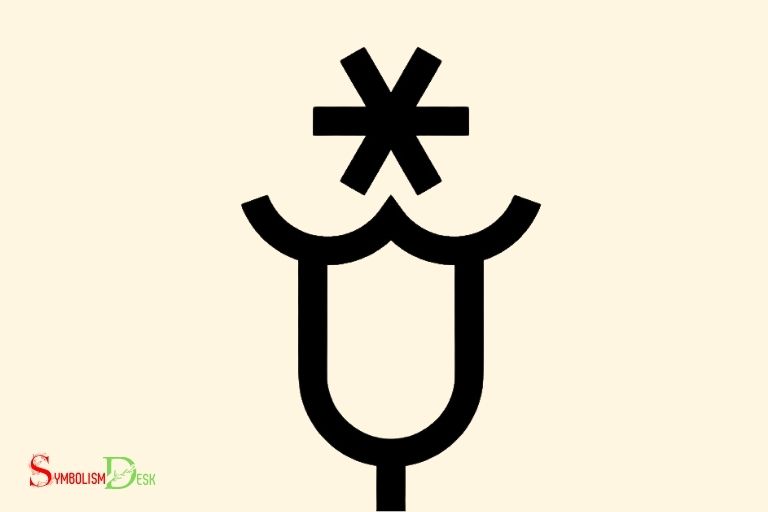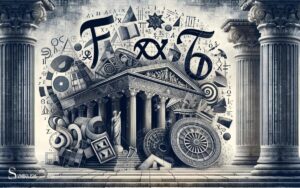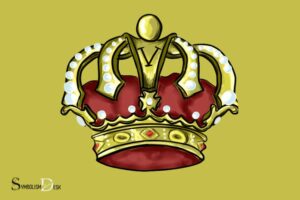What Does Hera’s Symbol Mean? Her Marriage to Zeus!
Hera’s symbol represents her status as the queen of the gods, her marriage to Zeus, and her role as the goddess of marriage, family, and motherhood.
Hera, the ancient Greek goddess and wife of Zeus, is often depicted with symbols that hold significant meaning and reflect her divine attributes.
Her primary symbols include the peacock, the cow, the pomegranate, and the diadem or crown.
In summary, Hera’s symbols hold deep meaning and significance, reflecting her divine attributes and roles as the queen of the gods, the goddess of marriage, family, and motherhood.
Her symbols, such as the peacock, cow, pomegranate, and diadem, showcase her beauty, watchfulness, nurturing nature, authority, and power over life and relationships.
Interpretation of Hera’s Symbol
| Hera’s Symbol | Symbol Meaning |
|---|---|
| Peacock | Representing her beauty, watchfulness, and immortality since the peacock replaces its feathers every year. |
| Diadem | Signifying her role as the queen of the gods and her royal power. |
| Scepter | Symbolizing her authority and command over the heavens and earth. |
| Pomegranate | Representing fertility, marriage, and abundance. |
| Cow | Associated with motherhood and her nurturing aspect. |
| Lotus Staff | Depicting her connection with nature and her power to bring about growth and harmony. |
Key Takeaway

Five Facts About: Hera’s Symbol Meaning
Together with Zeus, she birthe several children, including notable gods like Ares and Hephaestus. (Source: Greek Mythology)
Hera placed his eyes on the peacock’s feathers to honor him, hence symbolizing watchfulness and protection. (Source: Greek Myths & Greek Mythology)
In ancient Greece, pomegranates were often offered as wedding gifts to ensure happiness and fertility in the marriage. (Source: World History Encyclopedia)
The diadem, a type of crown, symbolizes her royalty, while the scepter represents her power and ability to govern. (Source: Greek Mythology)
Ancient Greeks built many temples in her honor, including the famous Heraion of Samos, which is considered one of the finest examples of ancient Greek architecture. (Source: Ancient Encyclopedia)
Who Is Hera And Why Is Her Symbol Important?
Overview Of Hera, Queen Of The Gods In Greek Mythology
Hera was the queen of olympian gods in greek mythology, known for her beauty, wisdom, and powerful nature.
As the sister and wife of zeus, she was one of the most revered goddesses of ancient greece.
Here are some key points about hera’s background:
- She was born to cronus and rhea, two titan deities.
- Hera was the goddess of marriage, fertility, and childbirth.
- She was known for her jealous disposition, which often involved her seeking revenge on those who wronged her.
- The peacock was considered hera’s sacred animal, and was also associated with immortality.
Historical Significance Of Her Symbol
The cow and the peacock feathers are two of hera’s symbols that hold significant historical importance.
Here are some key points:
- The cow was considered sacred in hera’s hometown, argos, and was a symbol of fertility and motherhood.
- The peacock feathers were also linked to the idea of immortality as they represent the “eyes” on the tail feathers which can see the past, present, and future.
- In ancient greece, hera’s symbols were often depicted in art and architecture to represent her power and divine status.
Importance Of Analysis And Interpretation Of The Symbol
Interpreting and analyzing hera’s symbols is crucial in understanding the significance of the goddess in greek mythology.
Here are some key reasons:
- Symbols help us understand the character traits and personality of hera in more depth.
- They allow us to understand the role of hera in ancient greek society and religion.
- Symbols are important in interpreting the myths and stories surrounding hera, and provide insight into the beliefs and values of ancient greeks.
Hera’s symbols such as the cow and the peacock feathers hold a significant place in understanding the mythology of ancient greece.
By analyzing and interpreting these symbols, we can gain a better understanding of the goddess, her powers, and her place in ancient greek society.
The Symbol Of A Peacock: Origins And Meanings
Description Of The Symbol Of The Peacock And Its Connection To Hera
The peacock is a popular symbol in many cultures, and it has various meanings associated with it.
In greek mythology, the peacock is linked with the goddess hera, the queen of gods and goddesses.
- According to the myth, hera’s sacred animal was a beautiful bird with many gleaming eyes on its plumage, which represented her power and authority.
- The peacock’s stunning feathers have become a symbol of her regal status, beauty, and immortality.
- As a peacock spreads its flashy tail feathers, it symbolizes hera’s spreading her sphere of power and influence throughout the world.
Historical Context Of Using Peacocks As Symbols In Various Cultures
Peacocks have been a symbol in various cultures throughout history.
- In ancient rome, the peacock’s image was carved into cups to protect wine from becoming sour.
- In asian cultures, the peacock represents beauty, royalty, and good fortune.
- In christianity, the images of peacocks symbolized the all-seeing eyes of god.
- The peacock also represents renewal through death and resurrection in eastern religions.
Analysis Of Different Interpretations And Meanings Of The Peacock Symbol In Relation To Hera
The peacock has many different interpretations in relation to the goddess hera.
- The peacock’s feathers resemble the all-seeing eyes of the goddess.
- The peacock’s plumage is viewed as a symbol of her pride and jealousy, which explains her wrathful nature towards zeus and his lovers in many myths.
- The peacock’s flamboyancy represents her power, majesty and wealth.
- The peacock’s feathers also symbolize renewal, rejuvenation, and immortality, reflecting hera’s eternal youth and beauty.
The peacock is a widely recognized symbol of glamour and vitality in many cultures, but it has a unique connection with the ancient greek goddess hera.
The peacock symbolizes her beauty, power and authority, and her ability to spread her influence all over the world each time it spreads its feathers.
Hera’S Cow Connection: Unpacking The Significance
Hera, the ancient greek goddess of love, childbirth, and marriage, has been portrayed in a plethora of symbols throughout history.
Her cow connection is one of the most interesting and significant of them all. Let’s dive deeper and explore what it represents.
Exploration Of The Cow As Another Important Symbol Of Hera
The portrayal of cows in greek mythology is associated with motherhood, nourishment, and fertility. Hera’s cow connection serves as an embodiment of these traits, making it a significant symbol.
Here are some key points to look at:
- Cows act as hera’s faithful companions in many myths, demonstrating their importance in the goddess’s life.
- The cow’s gentle and nurturing nature represents hera’s maternal aspect.
- The cow is a symbol of prosperity, reflecting the goddess’s association with wealth and abundance.
Mythological Stories Involving Hera And The Cow
Greek mythology is full of stories involving hera and cows, each with a unique meaning linked to the goddess.
Some of the most popular stories include:
- The famous story of hera’s transformation into a cow to escape from her husband zeus’s attention. In this story, she seeks refuge from zeus by appearing as a gentle cow, demonstrating her cleverness and resourcefulness.
- Another myth tells of the thousand-eyed argus, who watches over hera’s sacred cow in a field. In this story, the cow is considered a sacred animal, symbolizing devotion, loyalty, and vigilance – all of which hera embodies.
Symbolic Meanings Behind The Cow And Its Connection To Hera
Hera’s cow connection holds enormous significance in greek mythology and has several symbolic meanings attached to it,
Such as:
- The cow’s nurturing and nourishing nature represents a mother’s love, reflecting hera’s care and compassion for her people.
- The cow is also associated with fertility and abundance, embodying hera’s power over childbirth and growth.
- Finally, the cow connection in some myths represents the goddess’s ability to transform into any form she wants, reflecting her versatility, adaptability, and cunning nature.
The cow connection is an essential symbol of the goddess hera, embodying her maternal, nurturing, and protective qualities.
Its role in mythology provides a deeper understanding of hera’s character, shedding light on her multifaceted nature as a goddess of love, marriage, childbirth, and fertility.
The Lotus Flower: Hera’s Symbol Of Purity And Renewal
Overview Of The Lotus Flower Symbol And Its Association With Hera
Hera, the queen of heavens, is a powerful deity in the ancient greek pantheon, known for her grace, beauty and intelligence.
Throughout the ages, she has been associated with various symbols and motifs, but none more enduring than the lotus flower.
The lotus is a plant with deep religious and cultural significance, often used as a symbol of purity, renewal and enlightenment.
Here are some key points about the lotus flower and its connection to hera:
- According to ancient mythology, the lotus plant was created by hera herself, as a gift to the gods and goddesses.
- The lotus flower is often depicted in art and literature as a symbol of hera’s power, fertility, and divine grace.
- In ancient greece, the lotus was also associated with birth and rebirth, with the flower often being used in funeral rites and other religious ceremonies.
Exploration Of The Religious And Cultural Significance Of The Lotus Flower In Ancient Times
The lotus flower has a long and illustrious history, with its roots tracing back to ancient egypt and india.
Throughout the centuries, it has been imbued with deep religious and cultural meaning, representing spiritual enlightenment, purity, and renewal.
- In ancient egypt, the lotus was considered a symbol of creation and rebirth, with the blue lotus being associated with the god of the nile and the sun.
- In hinduism and buddhism, the lotus is a sacred flower, representing enlightenment and spiritual attainment.
- The ancient greeks also held the lotus in high regard, using it as a symbol of purity and grace, often associating it with their goddess hera.
Analysis Of The Symbolic Meanings Behind The Lotus Flower And How It Represents Hera’S Characteristics
The lotus flower is deeply symbolic, representing purity, rebirth, and spiritual enlightenment. In the context of hera, the lotus represents her grace, beauty, and divine power.
Here are some key symbolic meanings behind the lotus flower and how it relates to hera:
- Purity: The lotus flower is often associated with purity and divine grace, which are two of hera’s defining characteristics.
- Rebirth: The lotus is a symbol of rebirth and renewal, representing the cyclical nature of life. This is linked to hera’s role as a goddess of birth and fertility.
- Enlightenment: The lotus flower symbolizes enlightenment and spiritual attainment, which is associated with hera’s divine wisdom and intelligence.
The lotus flower is an enduring symbol of purity and renewal, with deep religious and cultural significance throughout the ages.
As hera’s symbol, it represents her divine power, grace, and beauty, and serves as a constant reminder of her enduring legacy. As Hera’s symbol, it represents her divine power, grace, and beauty, and serves as a constant reminder of her enduring legacy. Its elegance is often associated with themes of devotion and fidelity, reflecting the goddess’s role as the protector of marriage and family. Much like the cherry symbol meaning and purity, it embodies an unblemished essence, signifying Hera’s unwavering presence and influence in both mythology and mortal life.
Uncovering The Complexities Of Hera’S Symbolism
Hera, the queen of gods in greek mythology, is symbolized by various objects. These symbols reveal unique insights into her character and narrative.
Here, we explore the multi-layered meanings behind hera’s symbols and how they help us better understand this powerful figure in ancient greek culture.
Reflection On The Multi-Layered Meanings Of Hera’S Symbols
The symbols associated with hera had deep meanings attached to them.
Some of these symbols include:
- Peacock, which represents pride and leadership.
- Pomegranate, which represents fertility and abundance.
- Cow, which represents nurturance and maternal instincts.
- Diadem, which represents her royal status.
Importance Of Recognizing The Context And Historical Significance Of The Symbols
Hera’s symbols hold meanings that are relevant to the historical context and cultural norms of ancient greece.
For instance, the significance of the cow goes back to the original meaning of “hera” as the goddess of agriculture.
Understanding this context is crucial in understanding the complex meanings of hera’s symbols.
Exploration Of How Hera’S Symbols Can Help Us Better Understand Her As A Character In Greek Mythology
Hera’s symbols reveal her character traits and role in greek mythology. For instance, her association with the peacock highlights her pride and leadership abilities.
The pomegranate symbol emphasizes her connection to fertility and abundance, reflecting her protective and nurturing qualities.
In contrast, the cow’s symbol represents the conflict between her tender maternal nature and her terrifying rage when provoked.
Understanding these symbols can provide a deeper insight into hera’s character and her motivations in greek mythology.
Hera’s symbols are a testament to the rich complexity of greek mythology and the many layers of meaning behind every character.
It is only by careful analysis of these symbols that we can hope to understand the intricate psyche of this ancient goddess and her role in ancient greece.
What Does Auto Symbol 10 Mean in Relation to Hera’s Symbol?
Hera’s symbolism carries significant meaning, and within it, Auto Symbol 10 holds relevance. Auto symbol 10 meaning and coverage for hired vehicles is a crucial aspect to consider. This symbol represents protection for hired autos against physical damage or theft, offering security and peace of mind to Hera and those associated with her symbol.
FAQ About What Does Hera’s Symbol Mean
What Is Hera’s Symbol?
Hera’s main symbol is often depicted as a peacock. This symbolizes her pride and status.
Why Did Hera Choose A Peacock As Her Symbol?
Hera is often connected with the idea of beauty and royalty. The peacock with its beauty and grandeur is a perfect symbol for her.
Did Hera Have Any Other Symbols?
Yes, in addition to the peacock, hera was also associated with other symbols like the cow, pomegranate, and diadem.
What Does The Cow Symbolize For Hera?
The cow symbolizes motherhood, nurturing, and abundance, which were important aspects of the goddess.
Is Hera Still Worshipped Today?
Hera is no longer worshipped in the traditional sense, but some people still honor her as a representation of femininity and power.
Conclusion
As we conclude our exploration of hera’s symbol, it becomes clear that the peacock embodies the power and strength of this goddess.
The intricate design of the bird’s feathers represents the complexity of hera’s nature and the many qualities she possesses.
From her unwavering loyalty to her fierce protection of her family, hera is a goddess not to be underestimated.
The peacock symbolizes her regal presence and serves as a reminder of her connection to the natural world.
Understanding this symbol allows us to better appreciate the myths and legends that surround hera and the important role she played in ancient greek culture.
Whether we view her as a powerful force or a compassionate protector, there is no denying the significance of hera’s symbol and the lasting impact she has had on our world.






